-
Posts
1,261 -
Joined
-
Last visited
Content Type
Profiles
Forums
Events
Store
Posts posted by Andrej Stancak
-
-
10 hours ago, Chris Bristow said:
I think if it is fake it is because the image was rotated a few degrees too far.
Chris, what do you mean by "the whole image was rotated a few degrees too far"? Please explain how can this be done or what do you actually mean by the whole image being rotated.
-
Chris:
I checked your March 19 post and could not find any proof in your post that Lee Oswald's hip would have to be distorted beyond the anatomical range if he stood as he stood in the backyard picture. The degrees of freedom offered by the hip joint are large both in lateral and sagittal planes. You can have the pelvis only minimally turned backward and still have the foot extremely backward. The backyard image shows dark trousers and it is, in my view, impossible to measure how much the frontal plane of the pelvis deviated from the zero degree frontal plane (suggesting rotation). Please show it because a guess is not enough if you are implying a photographic manipulation with a historic piece of evidence.
So, if you want to say that the posture was tempered with, what has actually been done to the posture? Was it only the waist that was manipulated, was is all below the waist? The feet look all right and their orientation entirely possible, so I wonder what in the figure above its feet was manipulated.
You may wonder why I am not letting you to claim that the picture was manipulated because of a non-anatomical distortion of the hip. The whole assassination case is difficult to understand due to lack of chain of evidence, lack of evidence, missing or non-informative witness testimonies and a clear attempt to pin the guilt on Oswald whatever the truth was. However, the case is equally distorted by us, researchers, who spread unsubstantiated hypotheses and conclusions. I would suggest that you document your analyses and methods in an article, just like the Dartmouth study did, and let other evaluate all the steps. To repeat myself, the backyard pictures could have been manipulated but the rotation of the hip does not seem to prove it.
I will not partake in this thread if this is your preference.
-
20 hours ago, John Butler said:
Josephs reconstruction is a better way to look at it. The angle of Oswald's hips in the 133-A photo is a clear example of photo manipulation.
Gentlemen:
a claim that Lee's hips in the backyard picture were photographically altered is unsubstantiated. Lee had his inseam very low compared to the average male. and therefore, his whole hip region looked stiff and large. How can you reconstruct his pelvis and femurs from a photograph in which his hip is only visible partially and from only one angle? He wore trousers and those can confound the true location of femurs. The only way forwards is to provide a faithful 3D reconstruction of Lee's body (inlcuding the correct height of his inseam) using multiple photographs and then fitting the model onto his figure in the backayrd picture. This would tell if the pose was possible or not.
Chris: you may have overlooked my comment that the humanoid I used to reconstruct the pose is not an anatomical model of human skeleton. However, it allows to model any pose to figure out if it was anatomically possible at all.
Lee used to stand in very awkward poses. I have posted one yesterday in this thread. Please find here a reconstruction of his pose in that photograph which was taken while Lee had been on leave from the military. It is an awkward pose but this is how he used to stand - resting his weight on his right foot, unloading the left foot and having left foot forward and the left leg slightly bent in the knee joint. This is similar to his stance in the backyard picture. You may have also seen my post showing that Robert stood in a very similar fashion during Lee's funeral.
I do not say that the backyard pictures were not manipulated at all. However, it is not Lee's pose which would prove a photographic alteration.
This is my reconstruction of Lee's stance in the photograph taken during his leave while in military. The pose bears a striking similarity with his backyard picture pose in resting the body weight on his right foot and having his left foot forward and unloaded.

And this is Robert's stance during his funeral. While it is out of context here, Prayer Man's stance also bore similarities with both Lee's and Robert's stance.

-
5 hours ago, John Butler said:
The angle of the iliac blades seem to be wrong
John, this avatar is not an anatomical model of a human skeleton. However, it allows testing different poses and various articulations (joints).
-
This is one more example of an awkward looking pose by Lee Oswald in the left panel. I have modeled that pose (the right-hand panel) and overlaid it onto Lee's pose.

-
I have studied Lee Oswald's pose in the backyard photograph and even have tried to reproduce it myself. My conclusion was that he pose was not too stable but it was possible to stand that way. However, holding a gun like it is seen in the picture may have helped to maintain the pose as it shifted the centre of mass forwards and to the right.
This my reconstruction of Lee Oswald's pose using Andy2 humanoid avatar from Poser 11.1. I did not do any calculations of the centre of mass.
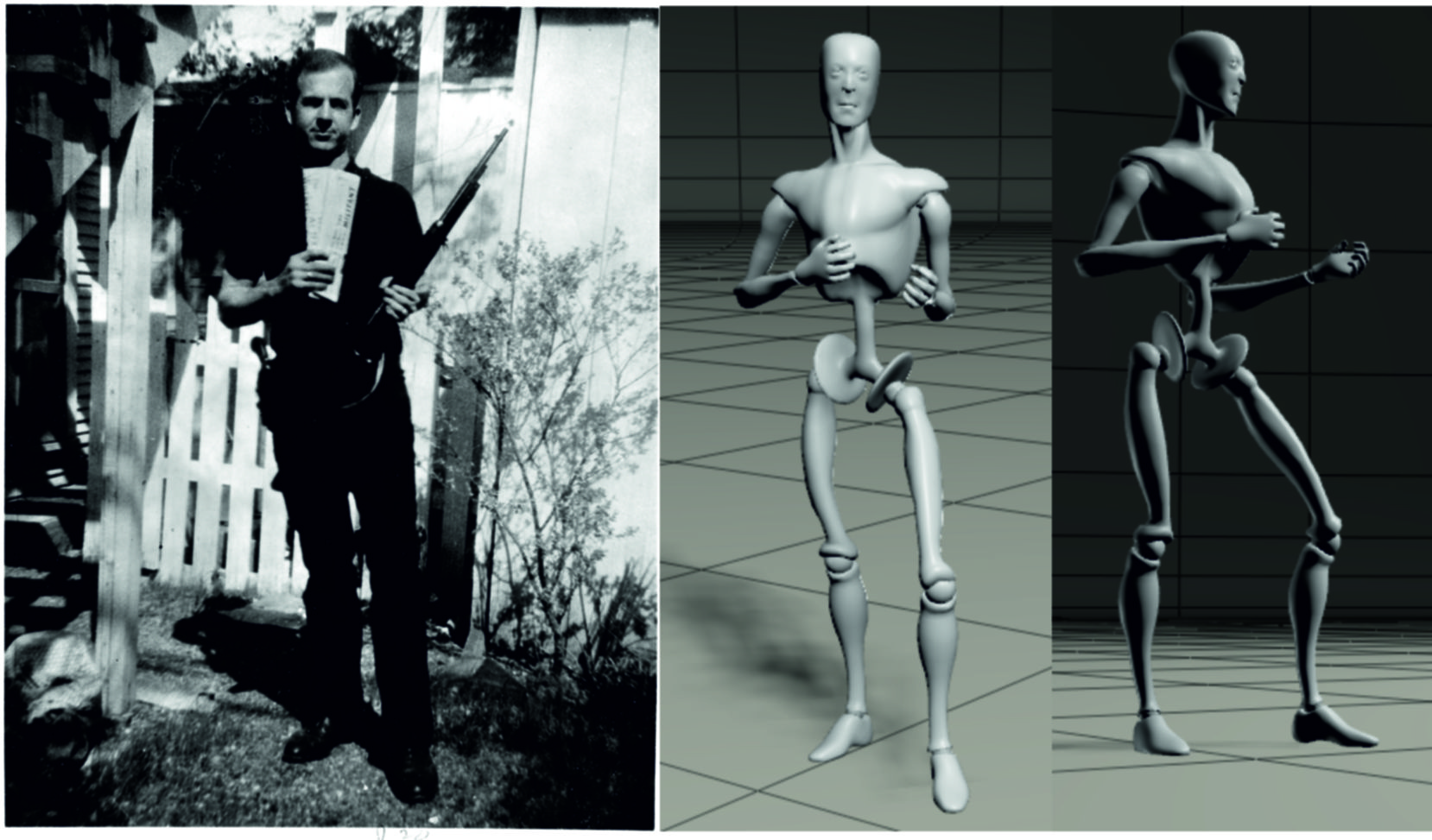
And this is the overlay of the model with the original picture:
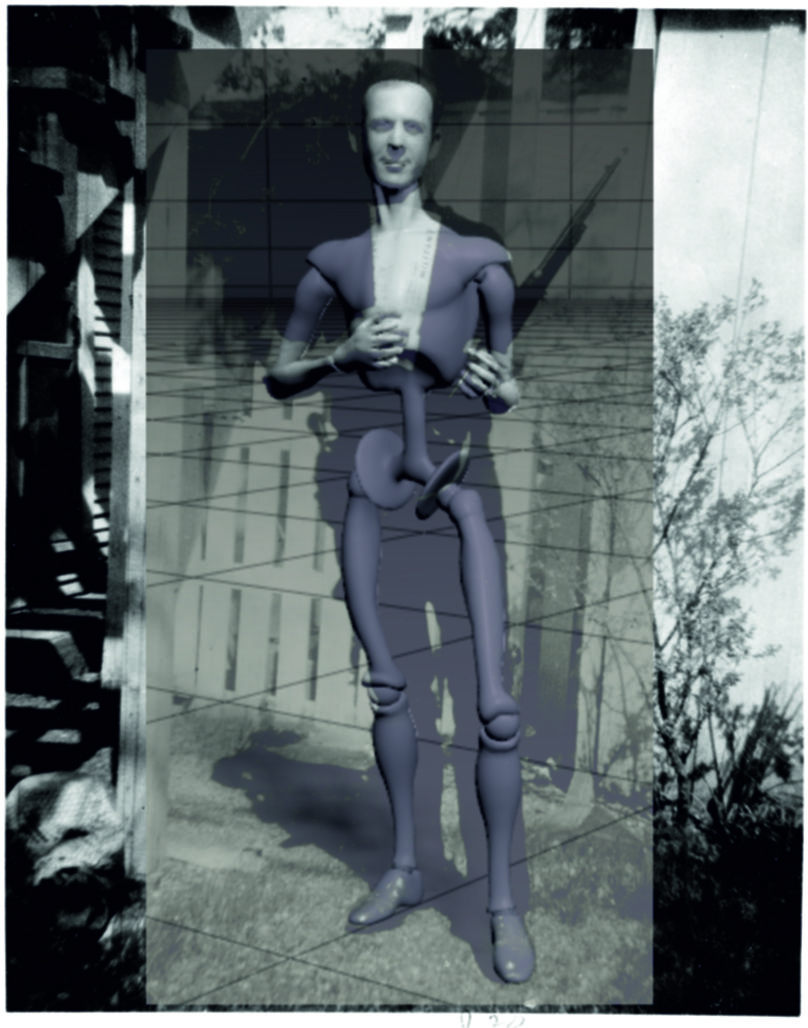
-
Greer turning back to have a glimpse of Kennedy suggests alterations to the Z film. As I remember the critical sequence in Zapruder film, Greer is seen to be looking back in one frame only. However, even the fastest movement with a minor body part such finger necessitates about 150 ms (it is for this reason that the tremor rate in Parkinson disease is 6-7/second giving roughly 150 ms per one movement). That would be about 3 frames for turning toward the President and a similar number of frames for returning his head to look straight.
-
Returning to Mrs. Stanton and where she can be seen in the assassination documents, I wondered about her body height which was given as an estimate by her family members to be 5'4''-5'6'' (interview by Mr. B. Doyle in June, 2018). I compared her body height with that of her son Larry in their family picture, downloaded from jfkassassinationforum.com , whereby Larry was 6' or 6'1'', also according to Mrs. Stanton's relatives. A simple calculation using known relationships in sizes of different intervals in human heads confirmed that Mrs. Stanton was either 5'6'' if Larry was 6' or 5'7'' if Larry was 6'1''.
Now, Mr. Buell Wesley Frazier was about of similar body height as Larry, 6' or 6' 1/4''. In the figure below, a yellow line crossing the tip of the light-colored hair of a person in the centre of the doorway crosses Mr. Frazier's face a bit too high, at the level of his eyes. So, either was Larry 6'1'' or, if Larry was 6', there should be some other explanation for seeing the top of the person with light-colored hair at Mrs. Frazier's eyes. I watched recently "Rush to Judgement" film by Mark Lane and in it there is an interview with Mrs. Nancy Hamilton who was once employed by Jack Ruby and told about his relationships with the Dallas Police. Mrs. Hamilton had her hair, possibly a perm, showing unusually tall front creating some kind of a wall, at least 3 inches, possibly 4 inches, high. I wonder if Mrs. Stanton could simply have her hair done in that style too on that fateful Friday and her hair could then easily be at least 1 inch higher than in her family photograph. Just this type of perm can inflate the height estimate by an inch or two. Further inflation of her body height could occur by wearing different shoes, possibly shoes with a slightly taller heel at work compared to when being at home, which very likely the case in most people. These two small details together can yield 2 inches above 5'6'' which is what is seen in Darnell still.

-
2 hours ago, Lance Payette said:
If I were to offer one observation with the utmost sincerity, it would be:
I’ve been involved for some 60 years in numerous areas of what debunkers dismiss as “woo-woo.” I’ve been a True Believer and a diehard skeptic, sometimes both within the same area of woo-woo. At least one area, Christian belief, involves scholarship and debate of the very highest level on all sides. I’ve seen it all – the games True Believers play and the games fanatical debunkers play. I know the nature of the arguments and the responses on both sides.
In almost every area of woo-woo, my positions have evolved and sometimes changed dramatically in one direction or another as I’ve become better informed and my critical-thinking skills have improved (largely due to 37 years of practicing law but also to fairly serious studies in epistemology). I can distinguish between nonsense on both sides and solid arguments on both sides. Had this not occurred, I guarantee I’d still be a gee-whiz conspiracy theorist insofar as the JFK assassination is concerned. Not just a conspiracy theorist but a True Believer.
You folks would do yourselves a great favor if you became better acquainted with (1) other areas where intense debate prevails, (2) the mistakes that True Believers make in all such areas (because they all make the same mistakes in reasoning and the handling of evidence), and (3) what it means to think critically and arrive at beliefs that are epistemologically sound.
You believe – most of you anyway – that you are doing serious research and thinking critically. But you aren’t. You simply aren’t. You are flailing in all directions as True Believers do in every area of woo-woo (and indeed even in more scholarly areas of intense debate) as they attempt to preserve and defend the house of cards they have constructed. You’re stuck on the True Believer treadmill, which I’ve characterized here as the Conspiracy Game (but doesn’t always have to involve a conspiracy – militant New Atheists and wild-eyed Christian fundamentalists do essentially the same things).
Maybe you enjoy the treadmill. Maybe it’s just a hobby or exercise for your brain or an opportunity for fellowship. But don’t kid yourselves that you’re moving toward historical truth, because you simply aren’t. As your mom perhaps used to say, “You need to get out more.”
What a cranky rant.
-
16 hours ago, Lance Payette said:
This is becoming a PP thread, and I'm not going to be sucked into that black hole. But an "estimate" derived from an amorphous blob standing in a position that cannot be precisely determined is inherently ambiguous. You're pretending to have a level of scientific certainty that you simply can't have from the available evidence.
Sorry, I am not intending to hijack the thread and am comfortable with people changing their views on Mrs. Reid's whereabouts. I am in the camp saying she could not see Oswald after the shooting but she could see him when he went up to buy Coke for his lunch.
As far as your sceptic attitude regarding the possibility to determine some very basic facts about Prayer Man, please find here a cropped view of the doorway from Darnell film. This version was downloaded from Prayer Man website and it has been enhanced which is all right for the purpose of this discussion. I believe it is relevant in the context of Mrs. Reid thread to say where actually Oswald was (or could be) during the time when she was returning to the building.

Please have a look on the images above and decide for yourself why would it not be possible to determine where is the tip of Prayer Man's head. I have drawn a yellow line in the right-hand panel to point to it. If you have this point and if the dimensions of the doorway and the view angle are known, the height of the tip of Prayer man's head relative to to the plane of the top landing can be estimated very accurately. This is not ambiguous or amorphous shape which would preclude any analysis.
You can also judge whether Prayer Man's hair was dark or light-colored. I see dark-colored hair and cannot understand why would anyone say that it is not possible to decide even such a simple thing whether Prayer Man's hair was dark or light. For a comparison, one of two arrows point to a person with light-colored hair (blonde or light grey). This light color is very different from Prayer Man's dark hair. I just cannot get why you say amorphous or ambiguous if these simple perceptual decisions are so easy to make. (By the way, the light-color hair person standing behind a shorter person with dark hair (Mr. Shelley) was Mrs. Stanton but this is a different story.)
-
48 minutes ago, Lance Payette said:
Your "probability analysis" would also have to take into account that, at this point, your nine "Oswald features" are little more than a Rorschach test. It would also have to take into account the other "small" problems I mentioned - not one person said Oswald was standing there, and Oswald standing there makes utterly no sense except according to a "we don't have to worry about anything" conspiracy theory that likewise makes no sense (at least to me).
No, Lance, the features I listed are not ambiguous features. They are such in your mind. Take the first one, the body height. The doorway was a well defined physical object with known dimensions and Prayer Man's head reaches to a certain height. There is nothing ambiguous in providing estimate of Prayer Man's body height. It is true that the task is beyond the capacities and skills of many researchers and those than try to make everything fuzzy and ambiguous.
I do not care what makes sense to you and what superstition you feel about researchers thinking that a conspiracy was behind the murder of President Kennedy.
48 minutes ago, Lance Payette said:Do you really not see what you are doing??? A stranger in the doorway isn't plausible because no one said there was a stranger in the doorway. (Was anyone asked a question that would have elicited such an answer?) However, the fact that no one mentioned Oswald in the doorway virtually proves this was Oswald because all those who didn't mention him were controlled and intimidated by the all-powerful forces of conspiracy.
Lance, please try to follow at least my responses. I took seriously your view that a stranger was posing as a Prayer Man. Please have a look on the FBI reports of Mrs. Stanton. In those she claimed that she did not see Oswald on that day. However, she then told her family the same story over the years that she actually saw him as he was going up to buy a Coke. She did not want to talk with any newsmen or researchers. In my view, she was explained by the FBI that it is to her advantage to say no to seeing Oswald. We cannot know who did or did not see Oswald if cases such as these perspired after many years.
However, Lee Oswald if he was out, he was out only for several tens of seconds. Prayer Man is not there in Hughes but he is there in Wiegman and Darnell (about 30 seconds after the last shot). The next mention of Oswald is by Ochus Campbell who saw him in the small storage room in the main vestibule about 2 minutes after the shooting. The people in the doorway were transfixed on the Tripple Underpass and may not have seen a person who came late and left early.
48 minutes ago, Lance Payette said:My humble belief is that you have devoted so much time and effort to Prayer Person that you have become the functional equivalent of a Harvey & Lee cultist or Lifton cultist. For you the photo simply has to be Oswald. But please, carry on with my blessings. I will await and even encourage the release of the high-resolution digital Darnell - which, if it shows a fortyish woman with a handbag, will immediately be declared a fake, an altered copy, or perhaps Oswald in a clever disguise. And so it goes.
I devoted a lot of time to this project and I think I am objective unless mere thinking that Prayer Man could be Lee Oswald is not a proof of the lack of my objectivity. It is a possibility which is supported by several clues and it needs to be explored to the bottom. I am not a cultist of any kind and would appreciate if you refrain from hanging such labels on me. The photo does not need to be Oswald and I am more than willing to study any alternative candidate. Actually I did that by testing if Mrs. Stanton or Jack Dougherty could be Oswald. Neither of them could.
-
On 9/12/2019 at 8:24 PM, Lance Payette said:
Prayer Man will never be anything more than Badge Man Revisited unless and until you have a clear photo that shows it actually is Oswald - at which point I will immediately become a gee-whiz conspiracy theorist, ready to believe almost anything.
The high-resolution digital copy of Darnell is with the Sixth Floor Museum. Unfortunately, they are not able give it to researchers other than viewing it at their premises on their equipment. I hope that when all the data regarding Prayer Man are presented to the public, this high-resolution version will be made accessible to researchers. However, the type of analyses I am doing would be necessary (and not different) even with the better-quality copy, so I do not thing that this work is lost.
As far as your explanation is concerned that someone unknown got to the doorway and posed as Prayer Man because he wished to find a spot in the shadow, this is not something I could endorse. First, none of the doorway occupants said that there was a stranger in the doorway. However, more importantly, this person is not there at his spot in Hughes film when the limousine was on Houston and was about to pass the front entrance of the Depository building. The idea that someone decides to search a shelter when the much expected moment came and the President is in direct view, or seconds later when shots were ringing out is just not likely.
Of course, the possibility that the man there was a stranger and he was one of about 400 bystanders who at that moment were at the Plaza needs to be considered and checked against the probability that this random person would share all of Oswald's features:
1. That stranger would be 5' 2 5/8, which is Oswald's body height (5'9'') plus less than an inch for shoe heel.
2. Would be a white Caucasian.
3. Would be a male.
4. Would have the same type of hairline as Oswald, both on the left and right temple. That type is known as Type II pattern of male baldness.
5. Would wear a worker type of clothes.
6. Whereby the grey color of his pants would match the grey of CE157 (Oswald's pants).
7. Whereby the grey of his shirt adjusted for the difference in shadow level for being in the shadow rather than in direct sunlight would match the colour of CE151, Oswald's shirt.
8. Whereby the dark spots on his shirt would match the distribution of dark spots on CE151.
9. The stranger would stand by placing the weight of his body on his right foot and have his left leg slightly forward and bent in knee joint. Such posture can be seen in a number of Lee Oswald's photographs. Interestingly, Lee's own brother Robert stood in the same fashion during Lee's funeral.
A stranger from outside the building even if making an unlikely decision to walk up the stairs when things were the most exciting would need to have all these features. The odds of this happening would be roughly 1:600,000 (and the posture and the dark spots on CE151 are not included in the estimate). The whole city of Dallas counted about 650,000 inhabitants in 1963. So, this is how likely it would be for a stranger to be Prayer Man. There are some funny data out there on what are the probabilities of unlikely events. The odds for events such as 1:600,000 would be about the odds that a person dies from being hit by a meteoroid.
-
1 hour ago, Lance Payette said:
1. Numerous TSBD employees were on the front steps at the time of the assassination or in the immediate vicinity. Not everyone recalled everyone else, but their recollections were quite good and paint a solid picture. Not one person recalled Oswald standing in full view where Prayer Person is standing. Does it seem plausible that not one person said “Gee, I seem to recall the guy you folks think is the assassin standing right there on the steps with us. Maybe you should look into that, huh?” But wait, there’s more …
Lance, that's the point, no one from those standing on steps of the doorway ever mentioned that there was someone at the western wall. Some have correctly mentioned few neighbors but others, such as Mr. Otis Williams, said they did not remember a single one. How strange. All the people standing there had a blind spot for the western wall. Even Mr. Frazier who stood some 2 feet away from Prayer Man. This I find strange. However, this person stood there, he can be seen at his spot in two films for a period of several seconds. If only one of the people in the doorway said who that person was and if that could be somehow verified, the whole case would be long over by now. But no, no one said anything about their neighbor at the western wall. Maybe they knew that that man was a big problem and chose not to say anything. Seeing no one standing to his left and right as Otis Williams said gave them a break.
Or, they did not spot that person (except Mr. Frazier who was too close not to register that man) which would be understandable if Prayer Man stood at this spot only for a short period time (e.g., 20 -30 seconds) and everyone was focused on the Tripple Underpass. But then, how are their testimonies relevant as to who this person was?
1 hour ago, Lance Payette said:2. Of all the photos and films taken that day – or that might have been taken that day – Prayer Person appears in precisely one. It is pure happenstance that there aren’t 15 photos in which Prayer Person is clearly identifiable. And in that one photo Prayer Person conveniently appears as such an amorphous blob in the deep shadows that debate continues as to whether said blob is a man or a woman. Prayer Person could be literally anyone – but, voila, it’s Oswald! But wait, there’s more …
There are not 15 photographs of the doorway in which Prayer Man is identifiable but there is more than one document - Darnell and Wiegman. You can say a lot about this person if you want to explore. You may wish to check the thread "Prayer Man is a Man" which contains quite a lot of details regarding Prayer Man's body height, stance, hands posture, clothing, hairline and even facial features. It is the simultaneous occurrence of several, not one, features which constitute a case of Prayer Man being Lee Oswald. All those features which are seen in Prayer Man cannot be found also in Lee Oswald by chance. Of course, it is difficult to extract some features just by looking on a photograph. Apparently, my effort is laughable and your ignorance is actually the correct attitude.
1 hour ago, Lance Payette said:3. What conceivable assassination conspiracy would have allowed the patsy who was supposed to be on the sixth floor shooting the President to be standing in full view on the front steps?
It was not that important for the conspirators where Lee Oswald was during the shooting provided they controlled the whole crime scene, all pieces of evidence, information going out, and even could allow silencing Oswald. The Dallas Police was in on it up to their necks. That said, Lee might have been asked to wait for a phone or a visitor so he lingered on in the back of the first floor until he heard the excitement as the motorcade emerged from Main Street and decided to go out.
-
Agent Hosty's handwritten account of what Lee Oswald told during his very first interrogation is of the strongest value regarding Lee Oswald's whereabouts. First, it is authentic Hosty's note. Second, it was taken as Oswald spoke which is of similar value as a stenographic or tape record. Third, it was taken within half an hour after Oswald's arrest before any communication among the interrogators could have occurred. Of course, other details of Lee's whereabouts were not discussed in this initial interrogation, such as who else could support Lee's alibi. Besides seeing Jarman and Norman, Lee Oswald also met Eddie Piper around the noon, and Mrs. Sarah Stanton later - that encounter is important because Mrs. Stanton had repeatedly told her relatives that she met Oswald on stairs when he was just going to buy Coke for his lunch. That encounter matches Hosty's note accurately. Mrs. Stanton would have been on her way out about 10 minutes (at least) before the arrival of the motorcade because Billy Lovelady who came out relatively early saw her through the glass window as she already stood out in the company of Bill Shelley.
Of course, there are also interrogators' report and witness testimonies which are in conflict with the scenario recorded by the FBI agent Hosty. In my view, the cover up kicked in very soon and since Hosty was eliminated from subsequent interrogations, he did not have a chance to attune to the follow-up interrogators' reports. There are good indications that Cpt. Fritz actually wrote his notes using James Bookhout's note as a template (shown by Mr. Murphy in the original Prayer man thread "Oswald leaving the TSBD?").
Thus, we face a situation that almost every aspect of this case is presented in two or more versions from which each can be chosen depending on which side of the picture one decides to ignore. For instance, who else besides Howard Brennan saw Oswald in the sixth-floor window? And even Brennan's testimony can be interpreted as confirmation of seeing Oswald in that window or absence of definitive certainty. However, there were eight other witnesses reporting seeing one or two men on the sixth floor and they all claimed seeing someone else, e.g. an elderly Afro-American man with balding hair. The testimonies of this sort, similar to Oswald's whereabouts according to different interrogators' notes, cannot be reconciled. They cannot be all valid at the same time.
It is for this reason that while continuing reading and studying books and articles, I focus my research on visual evidence. In my view, the data pertaining the unknown man standing in the western corner of the doorway in Darnell are sufficient to decide whether this man was Lee Oswald or not. As a better quality copy of Darnell film exists, there is still a hope that a high-quality copy of Darnell will be available to all researchers. This would help in deciding this very important question.
-
This is a less-known view of Prayer Man from frame # -3520 of the original film (upper panel). The image is blurred but it still shows, unlike other frames, some facial features including a slightly extruded space between the nose and upper lip. In the bottom row, Lee Oswald's face is shown for comparison purposes in different post-assassination photographs. He indeed had the naso-labial portion of his face slightly extruded. Please note also the bald spot on the left temple giving a specific shape of hairline. The two hairlines match very well.
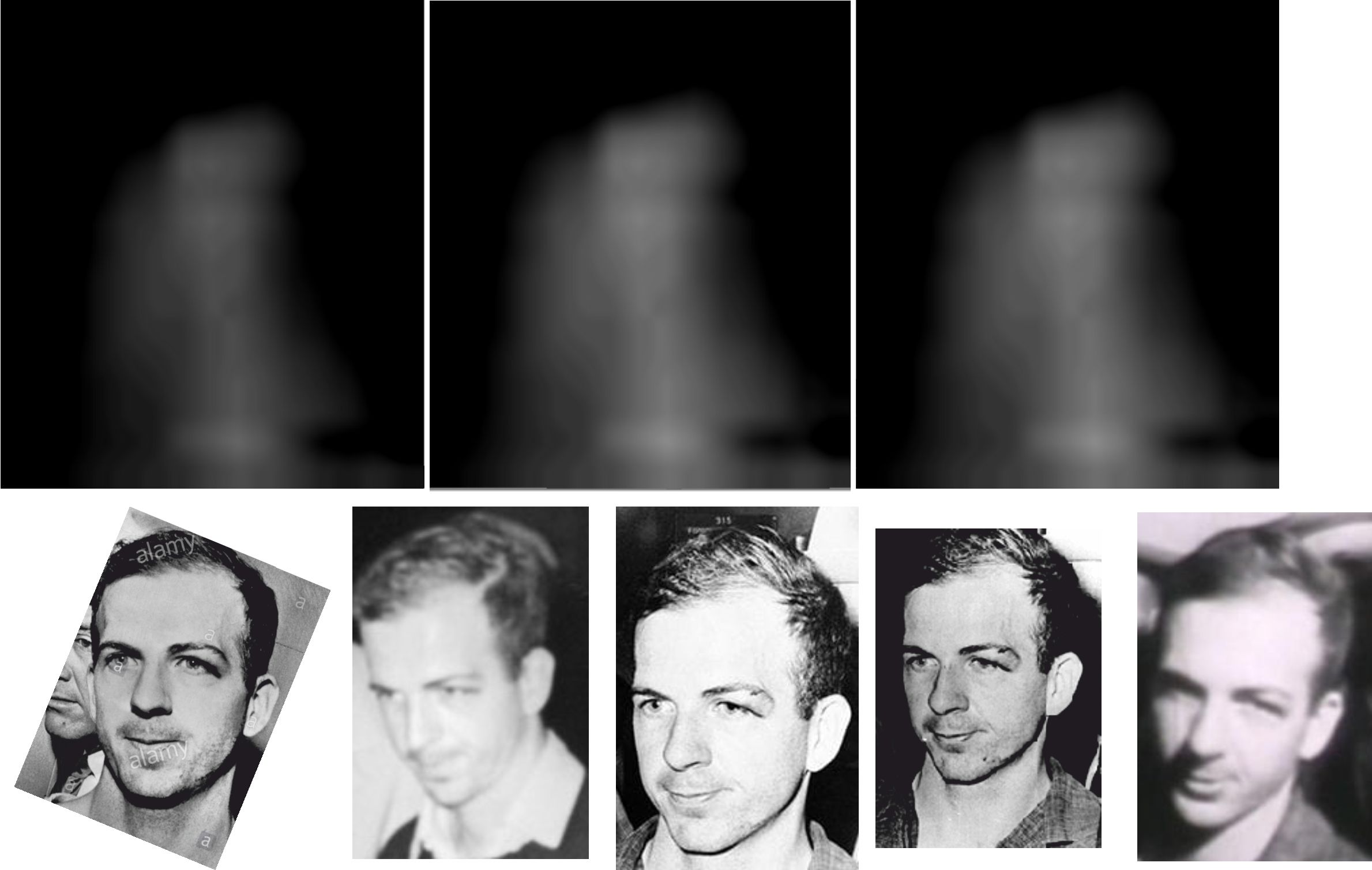
The next figure shows an overlay of Lee's face (the second picture from the right) with Prayer Man's face. At 0%, there is no overlay, only the original image from Darnell still. With increasing percentage, Lee's photograph in the background perspires more and more. The match appears to be undeniable, at least to me. It is not the only clue that supports the possibility that lee Oswald was Prayer man, however, it is a very concrete clue which as a minimum justifies further searching along this line.

-
Anything we post on this Forum and on Internet in general, e.g., a novel idea, theory, or an original image illustrating a theory, is an intellectual property of the poster. It can be referred to in own texts if properly quoted, not altered and not misinterpreted by the second author. It is very difficult to ensure that this general principle is followed. In practice, people copy and misinterpret the work of others without giving it any thought. However, this is a private Forum (although visible to a large audience) and it now has a rule that no member of this Forum can re-post full or large parts of other member's posts on another internet server. It is a good rule. It can be applied retroactively and therefore, David was rightly asked to remove the posts or parts of posts he copied along his posts on his own website. After he does it, his access to this Forum can be reinstated and I would be glad if this would be the final outcome and David would resume his posting here.
-
My suggestion would be to restore access to EF for David after he removes his EF archive from public view. There is no intellectual property problem in backing up own messages posted here, and even messages of others if all are kept in a private document and not publicised on own website. The new rule on Copyright ownership from yesterday is very useful.
I hope David will understand the intellectual property issue he is in involved with and removes his archive from his webpage. In that case, I would recommend reinstating David's access to EF.
-
The book contains number of speculations and presents Lee Oswald as a mentally unstable person. The book also makes parallels to the assassination of Abraham Lincoln which appears to be a speculation. If a reader abstracts from these aspects, the book still gives an interesting explanation of where Lee Oswald was during the time when he was supposed to be in Mexico City. The factual support for alleged Lee Oswald's presence in Washington, DC on September 27 is the following: 1) Lee's letters from end of August in which he hinted to be in Baltimore area on October 1. 2) Dick Russel's book on Richard Case Nagell who had warned the FBI about a plot to kill the President around the end of September. 3) Most importantly, the Secret Service report elaborated between December 2 and 5, 1963 in which SS agent Boring and another agent described witnessing of Lee Oswald's presence in Washington, DC by three people: a driver of a ministerial limousine Bernard Thompson, SS agent George (Hickey?), and a local police officer. Briefly, Bernard Thomas was a driver for the Ministry of Agriculture and waited for the minister's wife who was about to come out from Willard Hotel. He parked the limo outside the designated parking area and this was the moment when Lee Oswald allegedly exited the hotel and started to accost the driver for illegal parking. The nervous driver saw another governmental car in which an agent named George (Hickey?) was sitting and that agent recommended Thomas to keep a good eye on Oswald. Thomas then saw a local police officer who also came nearer to the scene and saw Oswald. It was at this moment when Lee Oswald decided to leave the scene. Thus, three people saw Lee Oswald in Washington, DC on Friday, the 27th September 1963.
The book is relevant in context of this thread as gives a reasonable explanation of where Lee Oswald was if he was not in Mexico City. The book is not referenced too well and appears to rely on Vincent Palamara's book without this being always clear.
-
Denny:
Lee's whereabouts on September 27, 1963 and a couple days around that day have been discussed in the recent book by Paul Blake Smith (a pseudonym?), "JFK and the Willard Hotel Plot".
-
To provide few more explanations to my previous post: Mrs. Sanders stood in the shadow which was cast by the top front edge of the doorway. In contrast, the bright semi-oval object between Shelley's and Lovelady's heads is lit by the sunlight. Anything in Altgens6 which was not directly illuminated bu sunlight appears as dark, almost black.This can be visualised on Shelley's head which looks as if cut into two parts by the shadow plane; it is hard to recognise any detail in the top part of his head which is in the shadow. This again refutes any possibility that the partial face next to Lovelady's left cheek could belong to Mrs. Sanders.
As Altgens6 was photographed from a slight bottom-up angle (due to the slope of south Elm street of about 3 degrees), objects standing on the same plane but one in the back and one in front would appear to be of different sizes. The perspective factor needs to be taken into account when comparing the heights of Shelley and Lovelady, but it also contributes to a further suppression of Mrs. Sanders' figure.
In 2016, in response to Richard Gilbride's query, I prepared a picture illustrating effects of different view angles on relative perceived body heights of two doorway occupants. It was posted in the old thread "Prayer Person - Prayer Man or Prayer Woman: a research thread" which is currently in \JFKResearch folder. The relevant post is dated April 6, 2016.
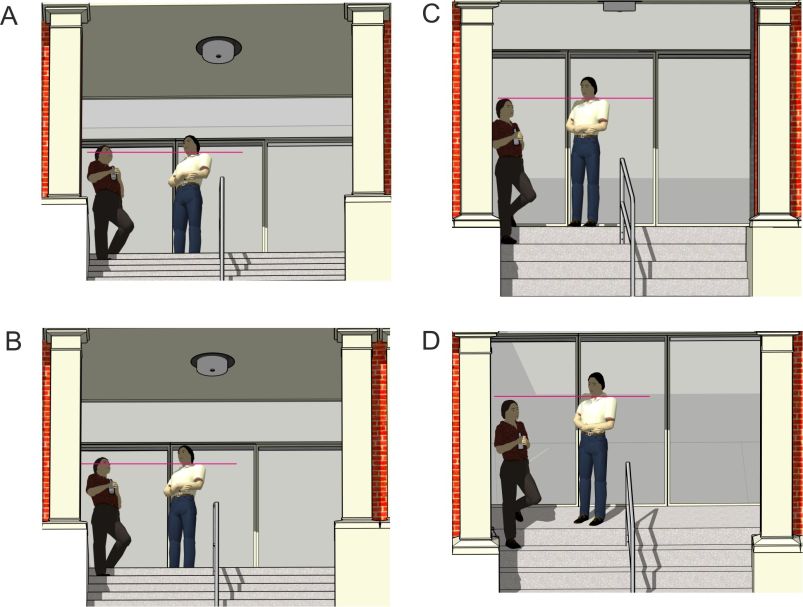
Briefly, the view angle varies in panels A-D from a very bottom-up view (A), to a slightly less bottom-up (B), to straight (C) and top-down view. The relative heights of two people of whom one is slightly in front (Prayer Man) of the other (Frazier) is back varies as a function of the view angle. If it is a bottom-up angle, the front figure appears higher than he is in reality (the horizontal purple line). In contrast, if we would look at the scene from a top-down angle, the man in front would appear shorter than the man behind. If applied to Altgens6 which was taken from a bottom-up angle, Lovelady standing on the second step (front) would appear as being taller compared to if he was shot from a straight angle. This explains why we do not see the full difference of one riser between Lovelady and Shelley - one was front and the other was back and the scene was shot from a bottom-up angle.
-
It is time to set few things straight concerning Mrs. Sanders and Mrs. Stanton as the problem of their whereabouts is grossly misinterpreted by one of our present and one of past Forum member. Unfortunately, these misinterpretations also involve personal and derogatory statements about my person and my work which, fortunately, are not ventilated here. It is not the disagreement of opinions but the total lack of respect to other fellow researcher's work which occurs to me as a character failure.
I have posted the figure of a person in Darnell still, whom I was initially not completely certain who that person was, on November 10, 2017 on this Forum, in the thread "Oswald leaving the TSBD?". The person stands in the eastern section of the doorway, in the shadow, meaning close to the glass door. Here is the initial picture:

I then added the finding of a shape between Lovelady’s and Shelley’s heads which I first spotted in 2015, and went through different interpretations of what that shape might have been, some of them wrong, some maybe not. That oval shape and the discussion on both Mrs. Sanders and Stanton were posted in my blog article on https://thejfktruthmatters.wordpress.com/ on January 31, 2018. This article contains two versions of Altgens6, one which I purchased from the Associated Press and the other being enhanced version of Atgens6 produced by Robert Groden. In both versions of Altgens6 (and in any other good-quality version of Altgens6), a light semi-oval object is seen behind Shelley’s head and aligns with Lovelady’s left cheek. This object is too large to be a photographic artefact. An explanation that this object was due to a reflection from the back of Shelley’s head is completely unrealistic and physically impossible as dark hair causes no light reflections into a plain space.
Here is the object of interest which I believe is a partial human face (Robert Groden's version of Altgens6):
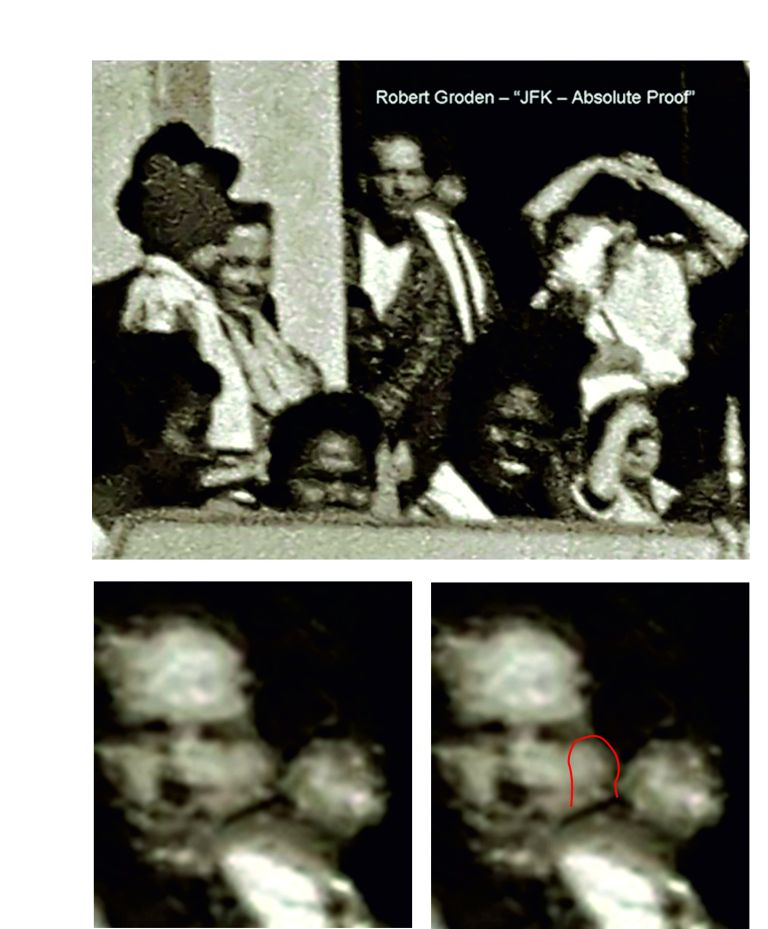
I would like to point to the following:
1. Mrs. Sanders stands in the eastern section of the Doorway and she is short. Please note that the top of her head reaches only to the shoulders of Mr. Shelley, the same man which is seen at this central spot on the top landing in Altgens6. I have estimated her body height to 5' or 5'1''.
2. In contrast, the oval object in Altgens6 is well above Shelley's shoulder level and it therefore belongs to a person who is much taller than Mrs. Sanders standing in the eastern part of the doorway. This partial face, I assume based on elimination of potential candidates, belongs to Mrs. Stanton who indeed herself said that she was in the vicinity of Frazier, Lovelady, Shelley and Sanders. I have estimated, back then in January 2018, that this person was 5’4’’ without knowing that the true height of Mrs. Stanton was 5’6’’ – this information surfaced only half a year later.
3. There was no possibility for the short Mrs. Sanders to cause the semi-oval object seen between Lovelady and Shelley. She was covered by Mr. Shelley’s and Lovelady's bodies completely. I have tested this possibility by placing into Altgens6 scene the figure of Mrs. Sanders at her spot in Darnell, and her figure was indeed completely covered by Shelley's and Lovelady's bodies.
4. It is important to point out that there was enough space for Mrs. Stanton to stand behind Lovelady as she stood on the top landing. In contrast, Billy Lovelady stood on the second step (in spite of his description in his testimony for the Warren Commission). If you do not trust my 3D reconstruction shown here, please employ simple reasoning. The lower aspect of Lovelady’s chin is below the lower aspect of Shelley’s chin. This could not be if both man were on the same platform because Shelley was shorter than Lovelady.
In the figure below, (A) shows Billy Lovelady if he stood on the top landing. He would appear too tall relative to Bill Shelley. (B) is correct. This analysis is the reconstruction of all doorway occupants lest Mrs. Stanton. (C) shows an overlay of the 3D model and Altgens6. It serves as a verification of my analysis. If all doorway features and all doorway occupants match, my analysis is plausible. In (D), a zoomed view of the same.

This an overhead view of Altgens6 with all occupants except Mrs. Stanton and Frazier. Please note the space on the top landing between Lovelady and Shelley which was available to Mrs. Stanton.
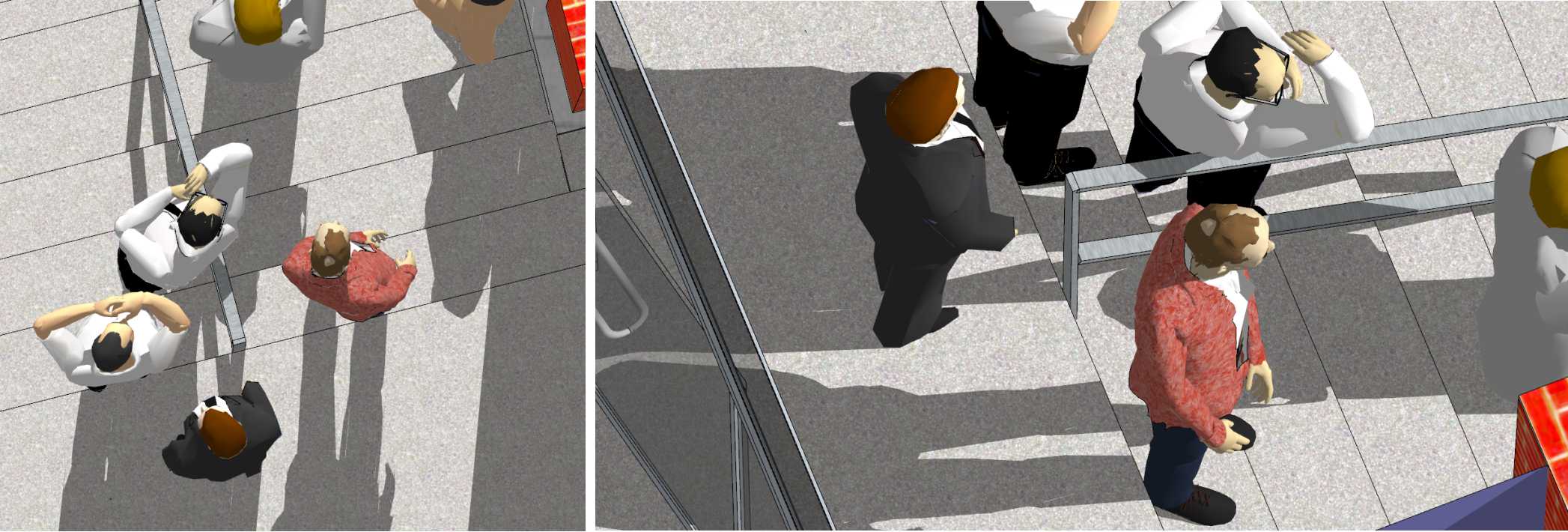
The last figure shows an exclusive logical OR overlay highlighting the region next to Lovelady's left cheek which could not be accounted by either Shelley's or Lovelady's head. One more unexplained spot is above Lovelady's right shoulder, and this is where Mrs. Stanton shoulder is seen as she was leaning to get her face to the space allowing her to view the street below. She was looking down eastwards, while Shelley was looking straight or up and also eastwards. In (A), a standard overlay of the 3D model and Altgens6. In (B), the logical exclusive OR overlay, and in (C)

-
Back to the problem of shadows on Prayer Man's arms. Eventually, after several weeks of very poor weather we had a beautiful sunny day in Liverpool allowing me to set up the shooting scene in the Calderstones park. (Calderstones park is located in south Liverpool and it spreads along Menlove Avenue on which a house known as Mendips can be found. This is the house where John Lennon lived with his aunt Mimi until he eventually left for London. On the other side of the Calderstones park is the school which back then was called Quarry Bank High School, and John most likely walked through the Calderstones park every day. Stawberry Fields was an orphanage in 1960' and it is located just above John's house).
The box in the scene below serves as a top step, and I used it to also reproduce the lights and shadows on Prayer Man's left leg.
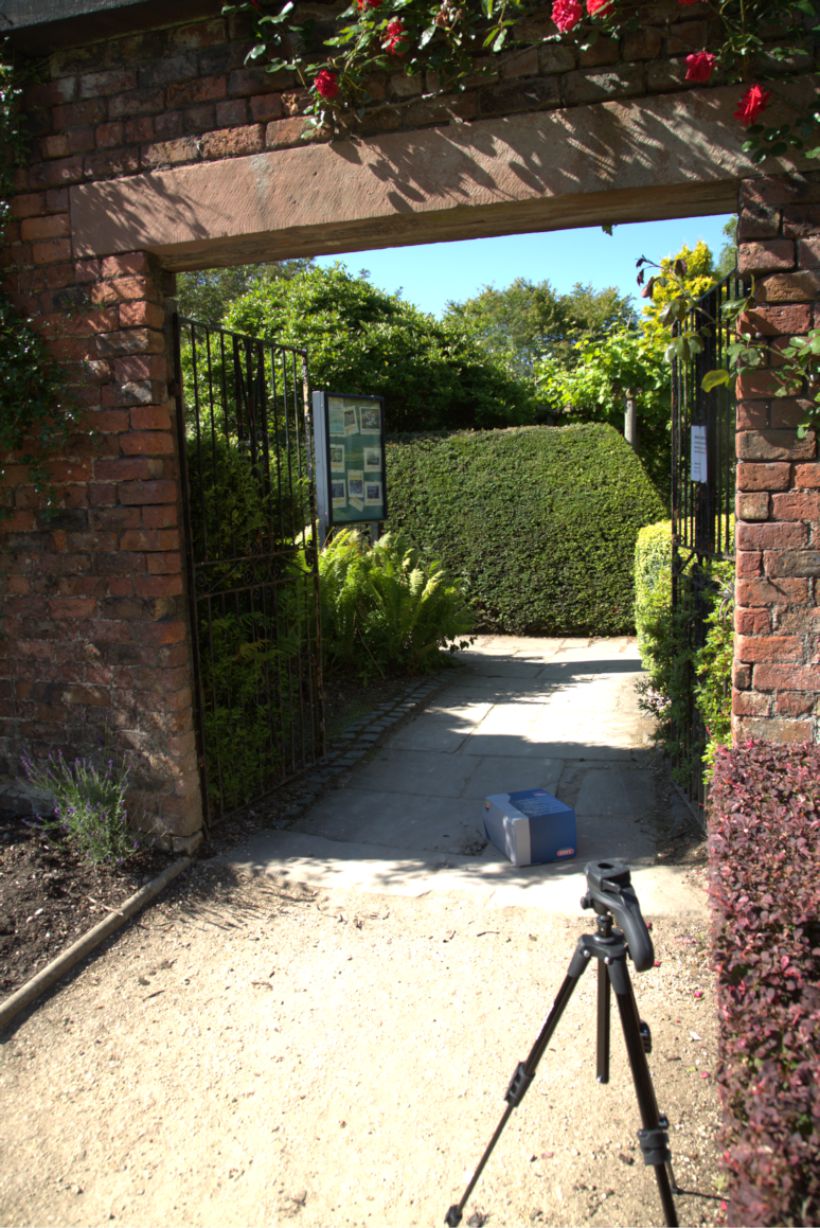
However, before showing my little experiment, let us look on Darnell still which was downloaded from jfkassassinationgallery.com. The numbers correspond to shades of grey with 0 representing black and 255 standing for white. The faces of Prayer Man and Buell Wesley Frazier give a dark tone in the range of 77-85. Prayer Man's hand was 112 which is brighter than the shade of the facial skin which is clearly in the shadow. However, it is less bright than the arm of Mr. Frazier (207) or the face of the man on a lower step who faces the sun. Notably, the cheek in that man's face is 172, suggesting that if the skin was not facing the sunlight flat, it tended to be less bright.

Thus, the situation is that somehow Prayer Man's right hand was neither in the complete shadow nor fully exposed to the sunlight. I made several experiments, and the two experiments shown below should shed some light on the problem. The right-hand column shows the right arm full in the shadow. This column starts with the original coloured photograph, and continues with a grey-scale version (second row) which was then blurred using Gaussian blur (20) and downsized to 3% and 1% of the original size. If the arm was completely in the shadow, the fleshy elbow region of the forearm was brighter than the back of the hand which is not what Darnell still shows. I have copied to cropped images from original Darnell stills in the bottom row of this figure. Thus, Prayer Man could not stand far from the shadow plane because his arm would not show the gradient with his hand being brighter than his elbow.
The left-hand side panel shows the right arm partially exposed to the sunlight. The arm is parallel to the plane of the shadow and it is in the shadow all right except two spots: the proximal part of the forearm and the back of the hand; the hand is bent and this is enough to expose a small part of the hand, perhaps only the knuckles, to the sunlight. Further steps approximate the process which affected the resolution and quality of Darnell still. Of course, my analysis can only demonstrate the principle, not the exact numerical values of grey in Darnell film. If the arm and the hand are as shown in in the top panel of the left-hand side column, the back of the hand will be glowing (254) and the proximal, fleshy forearm is at 157, less bright than the back of the hand. Please note that the middle part of the forearm is actually in the shadow. The brightness of the two critical spots decreases with each step of degradation: the hand 254 value drops to 208 after blurring the image with Gaussian blur, and each downsizing step decreases the brightness even more. The same happens to the spot in the proximal part of the forearm, although the decrease in brightness is less dramatic than in the hand spot. However, always the back of the hand is brighter than the fleshy part of proximal forearm.
The two Darnell frames provide the hint as to whether the arm was or was not exposed to the sun. I should say: partially exposed. The left-hand (bottom row) Darnell still is the frame 003636 and it yields the brightness of 140 of the hand spot, not that far from 155 in my experiment. The proximal elbow in my analysis (the 1% downsized and blurred image) and in the original Darnell show almost identical brightness level (115 vs. 114). The right-hand side bottom picture refers to a frame downloaded from jfkassassinationgallery.com. The whole picture appears to be darker, however, the comparatively brighter hand and the darker elbow can still be seen. The comparison of the two Darnell frames point to the problem with a direct comparison of numeric values of grey in Darnell and in any modern reconstruction: we do not know all the steps and processes applied to Darnell film which all could affect the overall level of dark and bright tones.
This little experiment shows that Prayer Man could not have his right arm fully in the shadow which would be the case if he would stand as close as possible to the western wall because we would hardly be able to see his right hand - it would be as blurry as his left hand. The solution with Prayer Man holding his right arm parallel with the shadow plane from which two little spots extruded into the sunlight (the back of the hand and the proximal forearm) reproduces the relative brightness levels along Prayer Man's right arm satisfactorily.
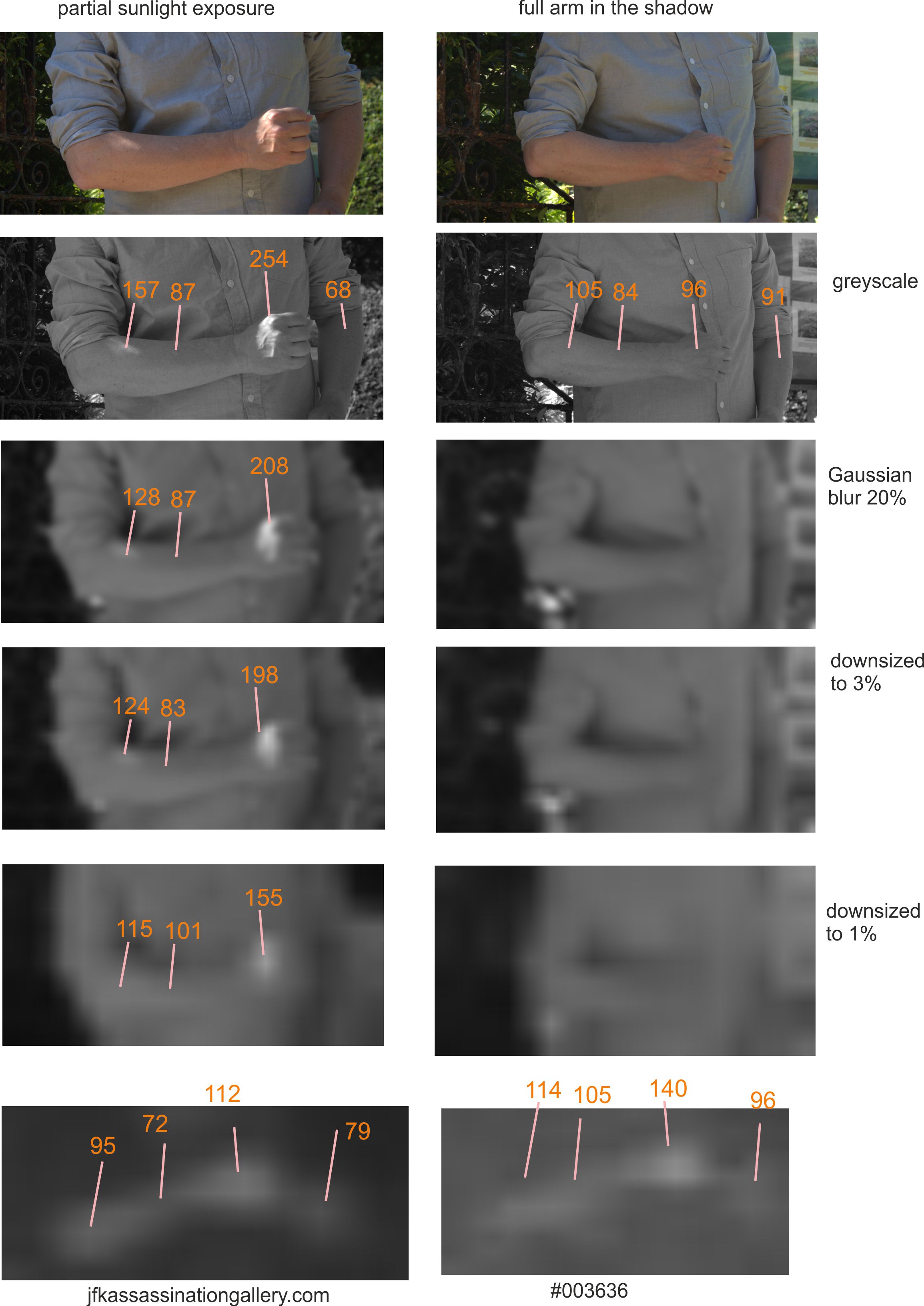
-
John:
I was able to grasp the possibility that a stranger, not Lee Oswald, standing on Elm street would get to the doorway and pose as Prayer Man, and I explained why this was very unlikely. It would never occur to me that you were thinking of Lee Oswald being outside the building as President's limo was moving down the Elm street, and he would then run to the Depository to position himself as Prayer Man. In the light of what is known about Lee's whereabouts during or after the shooting, and based on analyses of Darnell film to which I have also contributed, I cannot endorse your idea.
-
John:
you are not alone in suggesting that someone standing on street could climb up the depository doorway steps and pose as Prayer Man. You may understand that I see too many positive signs for Lee Oswald being Prayer Man, however, I appreciate your message because one cannot be careful enough to be carried away by an idea which can also be false.
Yet, I am not convinced that Prayer Man would be someone from outside, a bystander who just happened to pose as Prayer Man. First, there is no such person in the doorway in Hughes film. I can see Billy Lovelady in Hughes but not anyone next to him at Prayer Man's location. It is unlikely that someone would suddenly decide for getting to the doorway while the motorcade was already passing in front the Depository because such person had have enough time before the motorcade has arrived to choose a good spot. And people did choose their spots during the minutes preceding the motorcade (there is no such person in the doorway in Hughes, so I reckon nobody was interested). Prayer Man's spot at the western wall was a lousy spot - you could not view the south Elm street, grassy knoll, or Triple Underpass. The whole experience from watching the motorcade would be lost if a person standing on a curb of Elm street would choose to get into the Depository doorway when President's limo turned to Elm because the vanishing limo would not be seen from Prayer Man's spot.
There may be an option that someone got so scared by the shots that he/she would immediately seek a refuge in the Depository doorway. However, this is not what people did when shots rang out. Once the shot rang out, the ones who were really close to the source of shot(s) hit the ground immediately. That would be people like Newmans or Gordon Arnold. Other people would just stop and freeze. Willis's little daughter in red skirt is an example. After the shooting, people started to run, and here I can figure out that someone would just run into the doorway without knowing why. However, this would be already too late - Prayer Man was at his spot already in the initial sequence of Wiegman film and that spot at the western wall was not available for anyone to take. It should also be recalled that none of the doorway occupants, those standing on top steps, had ever mentioned a stranger standing with them on top steps.
I have looked into two of three candidate persons in your post, the ones I could see clearly. The figure below shows the two person wearing some reddish clothes in detail. The man in the left-hand panel appears to be a bit too old and severely balded. The person in the right hand-panel appears to me to be an Afro-American lady, however, I may be wrong.
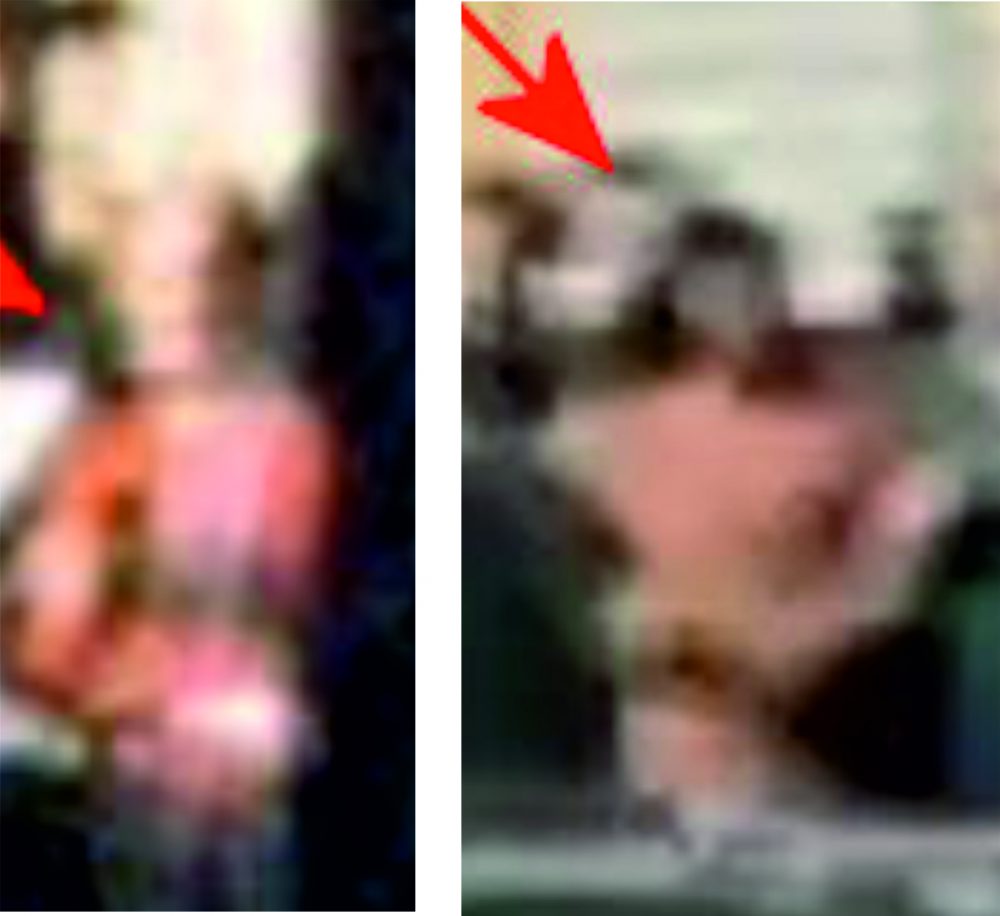


Dartmouth and the study of Oswald's lean in 133a
in JFK Assassination Debate
Posted · Edited by Andrej Stancak
Thanks, Chris, for correcting my wrong quote of "whole". Of course, this word is not in your text, it was my mind trying to figure out whether a part or the whole figure (maybe a better word than image) of Lee Oswald was rotated to achieve what you consider an impossible stance.
I am not an expert in photographic manipulation techniques but I do not think that this particular backyard picture was manipulated by drawing contours around the whole body and the rifle, extracting it and then pasting it onto another picture in a wrong angle. This would cause a number of associated issues with a mismatch in view angles and shadows and how the feet align with the plane of the ground. However, even if the picture was manipulated as you suggest, it would mean that the pose was anatomically possible and that a picture of Lee with a rifle was indeed photographed, only it would be used to place his figure onto the plain backyard of their Neeley Street house, photographed on a slightly different time (or day?).
But why would it be necessary to photograph Lee at the same place and to take a plain backyard picture and merge the two pictures? Or, was Lee photographed on a different place? But Marina did confirm that she had taken two pictures of Lee with his guns and newspaper one morning before the noon while they lived at Neeley Steet. Why then was it necessary to produce a picture using a photographic manipulation which would be the same that Marina had already taken?
As far as any reconstructions of Lee's posture are concerned, these would necessitate to have a person having the same height of inseam (Lee's inseam was quite low, about 38% of the body height, if I remember correctly, compared to average male population (48-49%)). Also, it is not only the weight of the object (the rifle) he held but also the exact length of the rifle and where Lee held it - these factors decide about the balance. From my experience with modelling different pictures, any reconstruction - real or digital - has only meaning if every detail is reproduced faithfully. This is why it takes me so long to get to complete any model - it is too much work and effort. For that reason I cannot invest myself into reconstructing Lee's stance in the backyard picture. Actually, I did start with modelling their house and especially their backyard, however, then I decided to prioritise the Depository doorway.
Late edit: The video linked below is by the scientist at Dartmouth University and it explains a few things about the shadows in the backyard photograph. The shadows look often weird and improbable to human eye, yet they can be reproduced if all aspect of the scene are considered. Of course, it needs to be done in 3D. There can be only one geometric solution for shadows in backyard photograph. There cannot be a situation that the shadows on the face and neck would be true but shadows elsewhere in the body would be false - that would be some manipulation with only part of the body, not with the whole figure.
One more late edit:
I found a screenshot of my model of the Neeley street house in which Oswalds rented one appartment. I remember that I have also modelled the backyard of that house.